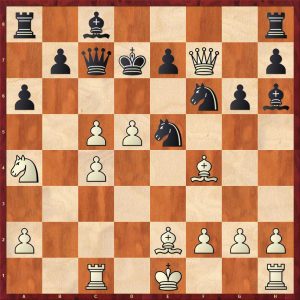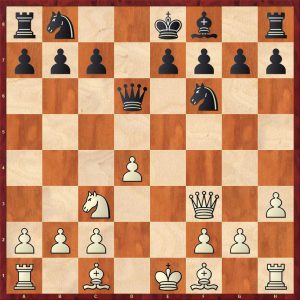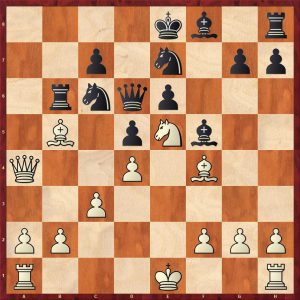
From the Publisher :
“The fifth volume of the Grandmaster Repertoire – 1.e4 series provides a top-class repertoire against the Alekhine, Scandinavian, Pirc and Modern Defenses, plus various offbeat alternatives Black may try. Negi’s latest work continues the winning formula of his previous books: the 1.e4 repertoire is founded on established main lines and turbo-charged with the innovative ideas of a world-class theoretician, making this an essential addition to the library of every ambitious chess player.”

I suspect that some of the keen proponents of these openings would strongly disagree that their pet opening is a minor defence to e4. Indeed, the popularity of some of these defences, in particular, the Scandinavian, would suggest that these openings are not easy for white to meet and the first player has to work hard to gain an advantage out of the opening. The sheer size of this volume shows that these so called lesser defences are pretty resilient.
This is where this book comes in, the quality of the analysis is impressive and there are plenty of original suggestions backed up by concrete lines and analysis which will arm the white player with much material. There is plenty of explanatory text that elucidates the main positional ideas in each chapter. The author pays particular attention to move order considerations which are particularly pertinent in the Pirc/Modern complex of openings.
As the title suggests, this is a book written from a 1.e4 white player’s point of view but there are many instances where Negi gives alternative variations for the first player to try. The suggested repertoire is generally dynamic and attacking but there are plenty of lines where white nurses a space advantage and positional pressure.
The book is divided into four sections:
- Alekhine
- Scandinavian
- Pirc/Modern
- Miscellaneous
Each section in then partitioned into logical chapters covering the major variations. The author skillfully manages transpositions with good cross references.
The first section on the Alekhine recommends the solid, Modern Variation with 4.Nf3 which is usually played at GM level. One particular line that has fascinated me for years is the variation 1.e4 Nf6 2.e5 Nd5 3. d4 d6 4.Nf3 dxe5 5.Nf3 Nd7 where black goads white into the tempting 6.Nf7. Bent Larsen tried this against Bobby Fischer in a blitz game in 1966 and was duly crushed. This line has been in the repertoire of some decent players and white, even when handled by an IM, has gone wrong and not pressed home the attack. The following game demonstrates this, but in the notes gives the refutation to this provocative fifth move. The author acknowledges that some of the analysis is taken from a book by John Shaw.
Eric Prie – Igor Alexandre Nataf Andorra op 15th 1997
1. e4 Nf6 2. e5 Nd5 3. d4 d6 4. Nf3 dxe5 5. Nxe5 Nd7? A provocative move, Bent Larsen famously played this in a blitz game v Bobby Fischer in 1966 and was crushed. 6. Nxf7

Kxf7 7. Qh5+ Ke6 8. c4 N5f6 9. d5+ Kd6 10. Qf7!

10…Ne5 11. Bf4 c5 12. Nc3 a6 13. b4!

Qb6 (13… b6 Black’s best try 14. Bd3! g6 15. bxc5+ bxc5 16. Rb1!!

An engine discovery, winning stylishly 16… Bh6 17. Rb7! Bd7 (17… Bxf4 18. Qxf6+ exf6 19. Ne4# Is the pretty point!

or17… Bxb7 18. Qe6+ Kc7 19. Bxe5+ Wins trivially) 18. Bg3 Rb8 19. Rxb8 Qxb8 20. O-O Qf8 21. Re1 Nfg4 22. Qf3!! Qxf3 23. gxf3 Rf8 24. Ne4+ Kc7 25. fxg4 Bf4 26. Be2 White has a winning endgame but some technique is still required to convert the extra pawn.)

14. Rc1 g6 15. Be2 Qc7

16. Na4? This is poor (16. bxc5+! Winning but care is still required. Qxc5 17. Bxe5+! Kxe5 18. O-O White a winning attack: Intending a combination of Rfe1, Na4, Bf3 and c4-c5, an example variation is given: Bh6 19. Na4 Qa3 20. Rc3 Qxa4 21. Qxe7+ Kd4 22. Rd3+ wins) 16… Bh6 ! 17. bxc5+? The final mistake (17. Bxe5+ Kxe5 18. f4+ Bxf4 19. Rd1 Bf5 20. g3 Raf8 21. gxf4+ Kd6 22. Qg7 b6 Black is probably better, but white can still fight) 17… Kd7

Now white is dead, the queens’s come off and he is left a piece down.} 18. Qe6+ Ke8 19. Qxe5 Bxf4 20. Qxc7 Bxc7 21. Nb6 Rb8 22. Bf3 Nd7 23. Nxd7 Ba5+ 24. Ke2 Bxd7 25. Kd3 Bb4 26. c6 bxc6 27. dxc6 Bf5+ 28. Ke2 Bc5 0-1
The second section deals with the Scandinavian. The Pytel variation 3…Qd6 is very trendy and this is one of the first chapters that I turned to. Here is an entertaining win by white in the 5…Bg4 line.
R. Horvath – P. Fauland 2018
1. e4 d5 2. exd5 Qxd5 3. Nc3 Qd6 4. d4 Nf6 5. Nf3 Bg4 6. h3 Bxf3 (6…Bh5 7.g4 Bg7 8.Ne5 Nbd7 9. Qe2! is a good pawn sac) 7. Qxf3

c6 ( 7… Nc6 8. Bf4 is good for white) 8. Bf4 Qd8 (8… Qxd4 9. Nb5! Is more or less winning)

9. d5! A crushing blow opening up the position for the better developed side

Nxd5 (9… cxd5 10. Bxb8 Followed by Bb5+
leads to major problems for black) 10. O-O-O e6 11. Nxd5 cxd5 (11… exd5 12.Qg3! Black finds it impossible to develop)

12. Bxb8 Qxb8 13. Bb5+ Ke7 14. Rhe1

a6 (14… g6 Is too slow 15. Rxd5 Bh6+ 16. Kb1 Rd8 17. Rxd8 Qxd8 18. Rd1 winning) 15. Qxd5! The play is now totally forcing. White has a forced mate or win of queen. axb5 16. Qg5+ Ke8 17. Qxb5+ Ke7 18. Qg5+ Ke8 19. Qb5+ Ke7 20. Rd7+ Kf6 21. Rxf7+!

Kxf7 22. Qd7+ Be7 23. Qxe6+ Kf8 24. Qxe7+ Kg8 25. Qe6+ Kf8 26. Qf5+ Kg8 27. Qd5+ Kf8 28. Qf5+ Kg8 29. Re7 Qe8 30. Qd5+ Kf8 31. Rxe8+ Rxe8 32. Qxb7 Black should have resigned here

g6 33. a4 Re7 34. Qc8+ Kg7 35. Qc3+ Kg8 36. a5 h6 37. a6
Kh7 38. b4 Rf8 39. Qc5 Ref7 40. b5 Rf5 41. Qc7+ R8f7 42. Qb8 1-0
The third sections deals with the Pirc/Modern complex. The repertoire suggested is the 150 Attack but is far more subtle than that, as white varies his setup according to the myriad black setups available. Below, is an instructive, thematic win by the editor, Andrew Greet.
Greet – Volovoj Correspondence 2019
1. e4 g6 2. d4 Bg7 3. Nc3 d6 4. Be3 a6 5. Nf3 Nd7!? 6. Bd3 e6 A bit
passive

7. Qd2 h6 8. O-O-O Ne7 9. e5 d5 10. h4! b6? 11. h5! g5 12. Nxg5! Crying out to be played and good, essentially winning

12…c5 (12… hxg5 13. Bxg5 Bb7 14. Ne2 c5 15. h6 Bf8 16. c3 Black is
defenceless on the kingside

13. Nxf7! Kxf7 14. f4 Black is a piece
for two pawns up, but he is poorly coordinated and cannot stop the advance of the pawns.

Kg8 15. g4 cxd4 16. Bxd4 Nc6 17. Bf2 Nc5 18. Bg6 Bb7 19. Rhe1 Qe7 20. Nxd5 A stylish finish

exd5 21. Bh4 Qd7 22. Bf5 Qc7 23. Qxd5+ Kf8 24. Qc4 a5 25. e6 1-0
The final section is on miscellaneous opening such as Owen’s Defence and the Nimzowitsch Defence.
I give an example of an offbeat line that is outrageous but not easy to refute, particularly in a blitz game. In this game, a 2400 player shows how to crush it.
Santo Roman – Palleja Toulouse 2000
1. e4 Nc6 2. Nf3 f5? 3. exf5 d5 4. d4 Bxf5 5. Bb5 e6 6. Ne5 Nge7 7. Nc3!

7…a6 (7… Qd6 8. Bf4 Is horrid for black) 8. Ba4 b5? (8…
Rb8 9. Bg5!Qd6 10. f4! b5 11. Bb3 Nc8?! (11… h6 Black can stay
in the game albeit with a lousy position) 12. Bxe7 Nxe7 13. O-O
Simple development leaves white with a big plus, or 13.g4) 9. Nxb5 axb5 10. Bxb5 Qd6 11. c3 Ra6 12. Bf4! Rb6 13. Qa4

13…Bc2 14. b3 g5 15. Bxg5 Rg8 16. Bxe7 Bxe7 17. Bxc6+ Kf8 18. O-O Black struggled on until move 37 but could have resigned here

Kg7 19. f4 Bf6 20. Bb5 Rgb8 21. Be2 Rd8 22. Rac1 Be4 23. b4 Qe7 24. Qd1 Kh8 25. a4 Bxe5 26. fxe5 Rbb8 27. Bd3 Qh4 28. Bxe4 dxe4 29. Qd2 Rf8 30. Qe3 Qg4 31. a5 Rg8 32. Rc2 Rbf8 33. Rxf8 Rxf8 34. Re2 Qf5 35. Rf2 Qh5 36. Rxf8+ Kg7 37. Rf1 1-0
My conclusion is that this is an excellent repertoire book for white, packed full of top quality analysis and much original analysis.
FM Richard Webb, Chineham, Hampshire, 19th December 2020

- Paperback : 432 pages
- Publisher:Quality Chess UK LLP (30 Sept. 2020)
- Language: English
- ISBN-10: 1784830771
- ISBN-13: 978-1784830779
- Product Dimensions: 17.42 x 1.96 x 24.16 cm
Official web site of Quality Chess

